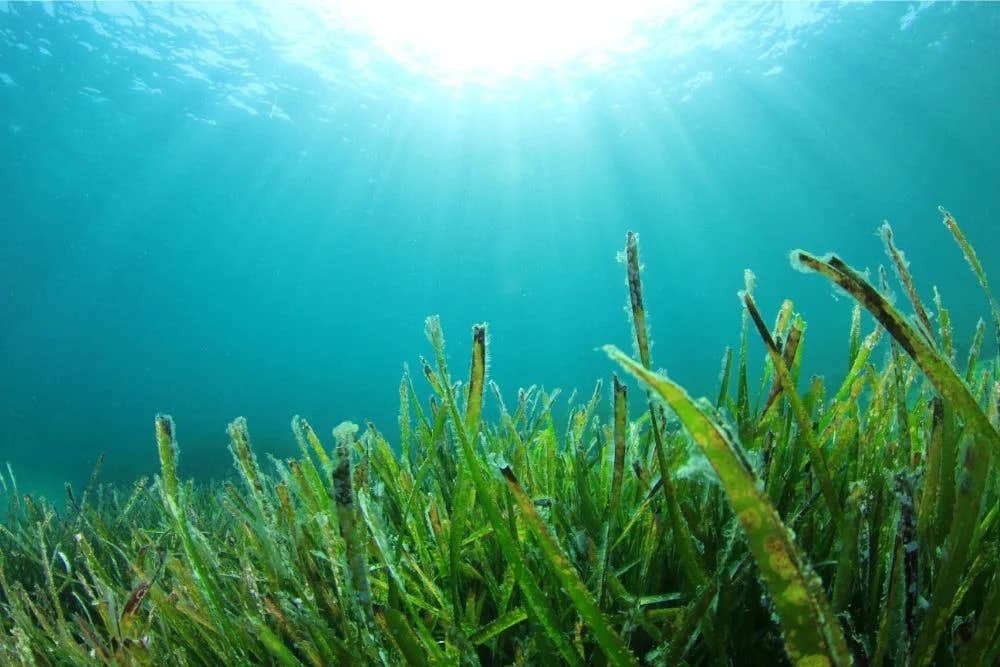Seaweed could alleviate world hunger, malnutrition, and mitigate climate change
Farmers around the world could have the potential to alleviate world hunger, combat malnutrition, and mitigate climate change.

[June 10, 2023: Staff Writer, The Brighter Side of News]
Farmers around the world could have the potential to alleviate world hunger, combat malnutrition, and mitigate climate change. (CREDIT: Creative Commons)
Farmers around the world could have the potential to alleviate world hunger, combat malnutrition, and mitigate climate change by switching their cultivation from land to sea, specifically to seaweed farming. This assertion forms the core of a new study conducted by the Friedman School of Nutrition Science and Policy at Tufts University, which was recently published in the Global Food Security journal.
The study, led by the esteemed Alexander McFarlane Professor of Nutrition at the Friedman School, Patrick Webb, along with co-authors Natalie Somers and Shakuntala Thilsted, looked extensively into the cultivation and sale of seaweed. Thilsted, a recipient of the 2021 World Food Prize for her remarkable work in aquaculture and food systems, is employed by the Consultative Group on International Agriculture Research.
During the research, the team examined a multitude of sources, including existing databases, research papers, reports from the United Nations and World Bank Group, among others.
The study concluded that seaweed cultivation could significantly bolster the earnings of farmers in low and middle-income countries (LMICs), particularly in coastal regions of Africa and Southeast Asia. As a more sustainable alternative to livestock rearing, seaweed farming demands neither land, freshwater, nor chemical fertilizers. With the global demand for nutrient-dense seaweed products on the rise, the authors believe that seaweed farming could prove to be quite profitable.
Related News
These anticipated profits would enhance the purchasing power of the households and communities involved in the production, processing, packaging, and exporting of the microalgae, ultimately promoting healthier diets.
“One of the most significant challenges of food insecurity in LMICs is the unaffordability of healthy diets,” Webb commented. As the director of the Food Systems for Nutrition Innovation Lab at Tufts, he noted the distressing fact that “there are roughly 3.5 billion people in the world who cannot afford a healthy diet even if they opt for local foods at local prices. For many of those people, cultivating and selling seaweed could lead to higher incomes and improved nutrition through purchases on the market.”
Seaweed: An Environmentally Friendly Choice
The research underscores seaweed as an eco-friendly crop that is both beneficial for the farmers and the environment. It has been cultivated using relatively simple techniques in parts of Asia for centuries.
Farmers initiate the process by attaching long lines of rope to the algae's roots, which nourish the plant by absorbing nutrients from the water. About six to eight weeks later, they manually collect the seaweed and allow it to dry under the sun. “A lot of what we're looking at on the farming side is not about finding new crops or different kinds of crops. It’s about what’s already being grown that could be scaled up cost-effectively,” Webb said.
Global trends in aquatic plant supply, 1971–2019. (CREDIT: Food and Agriculture Organization of the United Nations, 2022)
Furthermore, seaweed cultivation boasts a minute carbon footprint and may even assist in reducing the ocean's carbon levels. Although there is limited knowledge about how much CO2 seaweed emits during harvest, research has found that perennial brown algae farms absorb up to ten tons of CO2 per hectare of sea surface annually. As a bonus, seaweed can significantly curb methane gas emissions when included in livestock feed.
“Unless we get significant warming of the oceans, cultivating seaweed offers a way that is not just climate friendly, but climate proof,” Webb stated. “We don’t know how soon the industry will start to experience the negative effects of climate change, but the potential looks good. By farming seaweed, it’s not going to accelerate those negative effects. Whereas cutting down trees and adding more livestock certainly would.”
The Challenges of Production and Processing
Despite the many advantages of seaweed farming, climate change may present obstacles to its expansion. Increasing acidity levels in ocean water may inhibit the growth of healthy, edible seaweed, the authors warned.
Seaweed’s primary value for exports would be its extracts as ingredients rather than as a whole sea vegetable, according to the study. Nations with higher average incomes that produce and export brown, green, and red seaweeds in large quantities have the necessary infrastructure to process, test, and regulate seaweed products. However, most LMICs lack this capacity.
The scarcity of research into processing bottlenecks and the limited availability of data on factors such as consumer patterns, mostly held by the food companies that collected the data, pose challenges for governments and entrepreneurs in many LMICs to invest in aquatic plant farming.
“The steps taken between the farm and the fork, that’s what we need to focus on,” Webb emphasized. “We need to work more closely with governments and the private sector to figure out where the bottlenecks are and how to overcome them.”
A Future Bounty
The authors maintain that if these hurdles can be addressed, the possibilities of seaweed aquaculture are limitless. They cite the thriving industry in Indonesia, where seasonal labor is steadily available and farms can achieve industrial-level economies of scale, in contrast to family-run farms in countries like India and Tanzania. Indonesia is now a leading exporter of two seaweed species used to extract carrageenan, a thickener found in nut milks and meats.
Webb explained, “There are many different types of seaweed, and they all require somewhat of a different environment in which to grow. The vast coasts of Africa and Asia, not all of it will be prime real estate. But much of it will be.”
Webb called for governments to recognize the potential of seaweed farming and create food safety regulations and an overall environment conducive to its expansion. The interest of local and international investors will also play a critical role. “If it doesn’t happen tomorrow, with the right conditions, it could happen the day after tomorrow,” he predicted.
Webb expressed optimism about the future of seaweed production in LMICs. “The Ministry of Agriculture, or even the Ministry of Fisheries in these countries probably never discusses seaweed,” he observed. “What if they did? They might discover a goldmine.”
This study was funded in part by the United States Agency for International Development as part of the Feed the Future Food Systems for Nutrition Innovation Lab. The content of the research is solely the responsibility of the authors and does not necessarily reflect the official views of the United States Agency for International Development.
For more science and technology stories check out our New Discoveries section at The Brighter Side of News.
Note: Materials provided above by The Brighter Side of News. Content may be edited for style and length.
Like these kind of feel good stories? Get the Brighter Side of News' newsletter.



